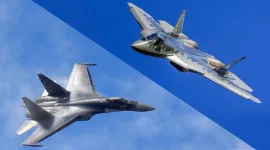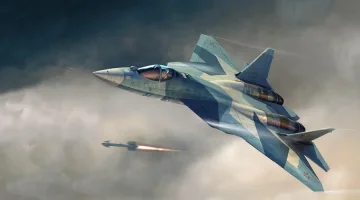- Views: 3K
- Replies: 17
The Indian Ministry of Defence is reportedly close to authorising a substantial ₹25,000 crore acquisition of the indigenously developed Quick Reaction Surface-to-Air Missile (QRSAM) system.
This move, anticipated to follow the successful completion of Limited Series Production unit deliveries within the 2024-25 financial year, is set to significantly bolster the Indian Air Force's (IAF) capabilities to neutralise aerial threats.
The procurement comes at a time of heightened vigilance, particularly concerning activities along India's western borders, and underscores a continued push towards self-reliance in defence manufacturing, even as discussions regarding the system's operational maturity and its integration into the IAF's comprehensive air defence framework continue.
The QRSAM, a product of the Defence Research and Development Organisation (DRDO), is engineered to offer a 360-degree protective shield against airborne aggressors.
Mounted on highly mobile Ashok Leyland 8x8 vehicles, the system is capable of intercepting a variety of threats including enemy aircraft, unmanned aerial vehicles (drones), and cruise missiles. It can engage targets up to a distance of 30 kilometres and at altitudes reaching 10 kilometres.
Key collaborators in this project include Bharat Electronics Limited (BEL) and Bharat Dynamics Limited (BDL).
The missile itself is a single-stage, solid-propellant projectile guided by a mid-course inertial navigation system, a two-way data link for updates, and a sophisticated terminal active radar seeker developed by DRDO's Research Centre Imarat, enabling precise target engagement.
The journey of the QRSAM began in 2014, initiated with an allocated budget of ₹476.43 crore. This indigenous development was pursued after the IAF decided against a global procurement effort, opting instead to develop a domestic solution to replace its ageing Soviet-era air defence systems, such as the OSA-AK and Kvadrat.
Since its inaugural test firing in 2017, the QRSAM has undergone numerous successful trials.
Notably, during the Aero India 2023 exhibition, BEL confirmed that the Indian Army had placed an order for five QRSAM weapon systems, with deliveries anticipated by 2024.
A standard QRSAM system is comprehensive, typically comprising a Regiment Command Post Vehicle, three battery units – each equipped with a Battery Surveillance Radar, a Battery Command Post, and four combat groups featuring multi-purpose radars and launchers capable of firing six missiles each – along with a complement of 72 missiles.
The impending large-scale order for the IAF is largely predicated on the successful conclusion of Limited Series Production (LSP) deliveries in the financial year 2024-25. The LSP phase is a critical step in defence procurement, indicating that the system has achieved initial operational requirements and is ready for broader induction.
This acquisition will considerably strengthen the IAF's multi-layered air defence network, which currently includes indigenous systems like the Akash (with a 25-30 km range), the Israeli Barak-8 (70 km range), and the long-range Russian S-400 Triumf (400 km range).
The QRSAM is designed to fill a crucial void in short-range, rapid-response air defence, offering quick reaction times and the ability to engage multiple targets simultaneously – up to six per launcher. This capability is particularly vital against contemporary low-altitude threats such as drones and loitering munitions, which have become increasingly prevalent in modern warfare scenarios.
Despite its advancements, the deployment of QRSAM has been accompanied by some scrutiny. Earlier, unconfirmed reports from 2022 suggested potential difficulties in detecting and engaging helicopters hovering at low altitudes and very close ranges. However, both the DRDO and the Ministry of Defence asserted that all tests conducted that year were successful.
Following feedback, including suggestions from the Army, improvements have been incorporated, such as a laser-based end-game fuze to enhance the missile's accuracy against highly agile targets.
While the system boasts a commendable 90% indigenous content, there are concerns regarding potential supply chain efficiencies. Bharat Dynamics Limited (BDL), tasked with missile production, has encountered delays in previous projects, such as the Astra Mk1 air-to-air missile.
Scaling up production to meet the substantial missile requirements of the IAF could present a challenge to its existing capacity. Furthermore, the IAF’s air defence architecture continues to rely on foreign systems like the S-400, and deliveries of the remaining two S-400 units have been delayed due to the ongoing conflict in Ukraine, highlighting complexities in India's pursuit of complete self-reliance in critical defence technologies.
The QRSAM’s induction is expected to fortify the IAF’s Integrated Air Command and Control System (IACCS), a network that allows for seamless coordination between various radar and missile systems to ensure comprehensive surveillance and response.
However, the IAF faces a broader operational challenge with its current squadron strength at 31, below the sanctioned 42.5 squadrons. This shortfall could impact its ability to maintain exhaustive air defence coverage across India's extensive borders, even with the addition of advanced systems like the QRSAM.
Some defence analysts also argue that the emphasis on short-range systems might divert resources from critical long-term initiatives like Project Kusha, an ambitious plan to develop a long-range air defence system with a 350 km reach, slated for completion around 2028-29. Project Kusha is seen as vital for countering advanced threats such as stealth fighters and ballistic missiles from potential adversaries, including China.


